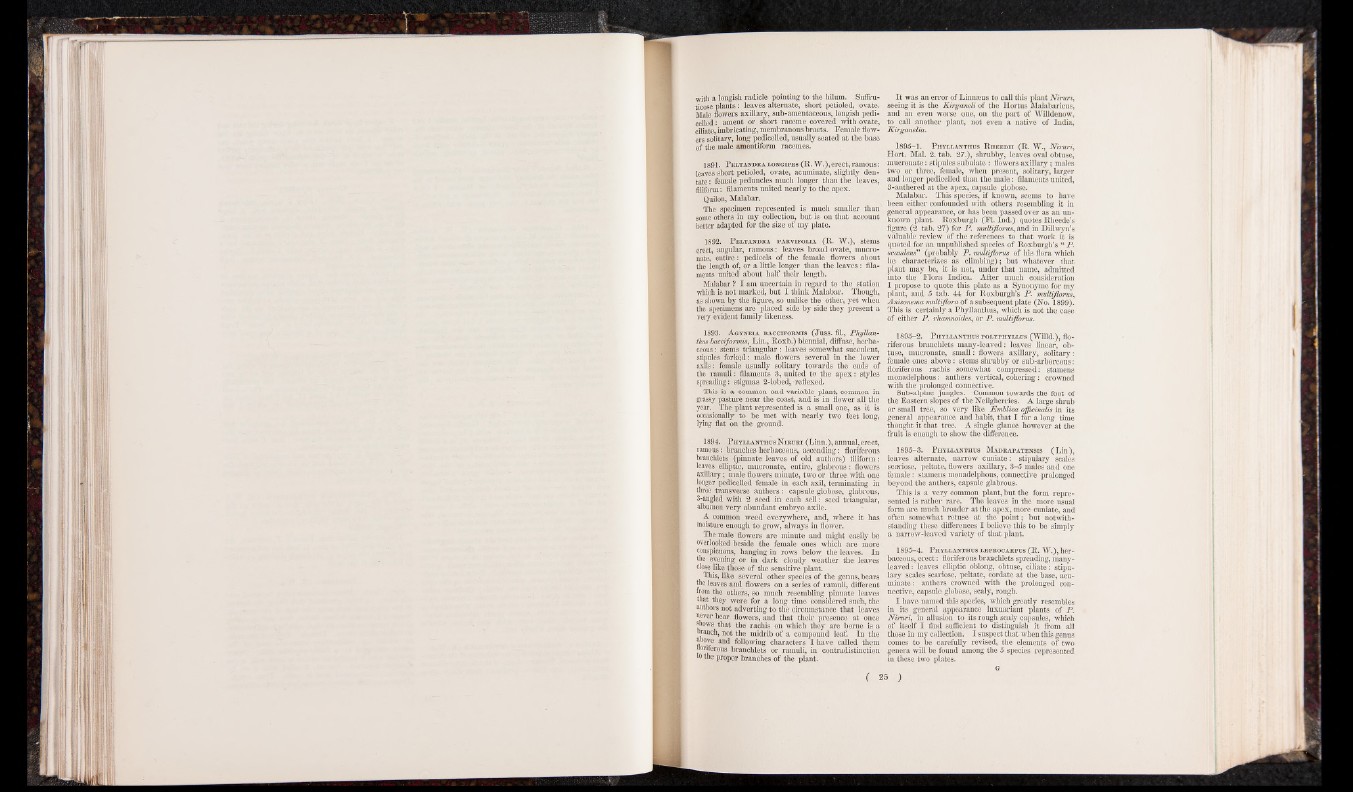
with a longish radicle pointing to the hilum. Suffru-
ticose plants: leaves alternate, short petioled, ovate.
Male flowers axillary, sub-amentaceous, longish pedi-
celled: ament or short raceme covered with ovate,
ciliate, imbricating, membranous bracts. Female flowers
solitary, long pedicelled, usually seated at the base
of the male amentiform racemes.
1891. Pbltandra longipes (R. W.), erect, ramous:
leaves short petioled, ovate, acuminate, slightly dentate
: female peduncles much longer than the leaves,
filiform: filaments united nearly to the apex.
Quilon, Malabar.
The specimen represented is much smaller than
some others in my collection, but is on that account
better adapted for the size of my plate.
1892. Peltandra parvifolia (R. W.), stems
erect, angular, ramous: leaves broad ovate, mucro-
nate, entire: pedicels of the female flowers about
the length of, or a little longer than the leaves: filaments
united about half their length.
Malabar ? I am uncertain in regard to the station
which is not marked, but I think Malabar. Though,
as shown by the figure, so unlike the other, yet when
the specimens are placed side by side they present a
very evident family likeness.
1893. Agynela bacciformis (J uss. fil., PhyUan-
thus bacciformis, Lin., Roxb.) biennial, diffuse, herbaceous
: stems triangular: leaves somewhat succulent,
stipules forked: male flowers several in the lower
axils: female usually solitary towards the ends of
the ramuli: filaments 3, united to the apex: styles
spreading: stigmas 2-lobed, -reflexed.
This is a common and variable plant, common in
grassy pasture near the coast, and is in flower all the
year. The plant represented is a small one, as it is
occasionally to be met with nearly two feet long,
lying flat on the ground.
1894. Phyllanthus N iruri (Linn.), annual, erect,
ramous: branches herbaceous, ascending: floriferous
branchlets (pinnate leaves of old authors) filiform:
leaves elliptic, mucronate, entire, glabrous: flowers
axillary; male flowers minute, two or three with one
longer pedicelled female in each axil, terminating in
three transverse anthers: capsule globose, glabrous,
3-angled with 2 seed in each sell: seed triangular,
albumen very abundant embryo axile.
A common weed everywhere, and, where it has
moisture enough to grow, always in flower.
The male flowers are minute and might easily be
overlooked beside the female ones which are more
conspicuous, hanging in rows below the leaves. In
the evening or in dark cloudy weather the leaves
close like those of the sensitive plant.
This, like several other species of the genus, bears
the leaves and flowers on a series of ramuli, different
from the others, so much resembling pinnate leaves
that they were for a long time considered such, the
authors not adverting to the circumstance that leaves
never bear flowers, and that their presence at once
snows that the rachis on which they are borne is a
branch, not the midrib of a compound leaf. In the
above and following characters I have called them
floriferous branchlets or ramuli, in contradistinction
to the proper branches of the plant.
I t was an error of Linnmus to call this plant Niruri,
seeing it is the Kirganeli of the Hortus Malabaricus,
and an even worse one, on the part of Willdenow,
to call another plant, not even a native of India,
Kirganelia.
1895-1. P hyllanthus Rheedii (R. W., Niruri,
Hort. Mai. 2. tab. 27.), shrubby, leaves oval obtuse,
mucronate: stipules subulate: flowers axillary; males
two or three, female, when present, solitary, larger
and longer pedicelled than the male: filaments united,
3-anthered at the apex, capsule globose.
Malabar. This species, if known, seems to have
been either confounded with others resembling it in
general appearance, or has been passed over as an unknown
plant. Roxburgh (FI. Lid.) quotes Rheede’s
figure (2 tab. 27) for P . midtiflorus, and in Dillwyn’s
valuable review of the references to that work it is
quoted for an unpublished species of Roxburgh’s “ P.
scandens” (probably P . midtiflorus of his flora which
he characterizes as climbing); but whatever that
plant may be, it is not, under that name, admitted
into the Flora Indica. After much consideration
I propose to quote this plate as a Synonyme for my
plant, and 5 tab. 44 for Roxburgh’s P . midtiflorus,
Anisonema mvltiflora of a subsequent plate (No. 1899).
This is certainly a Phyllanthus, which is not the case
of either P . rhamnoides, or P . midtiflorus.
1895-2. Phyllanthus polyphyllus (Willd.), floriferous
branchlets many-leaved: leaves linear, obtuse,
mucronate, small: flowers axillary, solitary:
female ones above: stems shrubby or sub-arboreous:
floriferous rachis somewhat compressed: stamens
monadelphous: anthers vertical, cohering: crowned
with the prolonged connective.
Sub-alpine jungles. Common towards the foot of
the Eastern slopes of the Neilgherries. A large shrub
or small tree, so very like Emblica officinalis in its
general appearance and habit, that I for a long time
thought it that tree. A single glance however at the
fruit is enough to show the difference.
1895-3. P hyllanthus Madrapatensis (Lin ),
leaves alternate, narrow cuniate: stipulary scales
scaviose, peltate, flowers axillary, 3-5 males and one
female: stamens monadelphous, connective prolonged
beyond the anthers, capsule glabrous.
This is a very common plant, but the form represented
is rather rare. The leaves in the more usual
form are much broader at the apex, more cuniate, and
often somewhat refuse at the point; but notwithstanding
these differences I believe this to be simply
a narrow-leaved variety of that plant.
1895-4. Phyllanthus leprocarpus (R. W.), herbaceous,
erect: floriferous branchlets spreading, manyleaved:
leaves elliptic oblong, obtuse, ciliate: stipulary
scales scariose, peltate, cordate at the base, acuminate:
anthers crowned with the prolonged connective,
capsule globose, scaly, rough.
I have named this species, which greatly resembles
in its general appearance luxuariant plants of P.
Niruri, in allusion to its rough scaly capsules, which
of itself I find sufficient to distinguish it from all
those in my collection. I suspect that when this genus
comes to be carefully revised, the elements of two
genera will be found among the 5 species represented
in these two plates.
G